The Chinese pocketknife brand, FengHua, is a new brand to me. There’s not much information about them online, however. Extremely little, in fact. From my understanding, FengHua appears to be the premium sub-brand of a group of brands. WIN+, another member brand I am also unfamiliar with, sells the budget-end knives of the group. Dreamtech, yet another unfamiliar member brand, looks to be their middle-tier.
Oddly, it’s impossible to tell which of the 3 brands is the company’s primary brand. For example, their Our Story page (that URL is misspelled, BTW) and their “blog”, located deep at the bottom of their homepage, indicate WIN+ as the primary brand.
However, their About Us page refers to their company as dreamtech-ltd, the homepage URL, based on the root domain MyShopify.com, is located in the subdomain dreamtech-ltd, and their Instagram page is @dreamtechknives. This is a very confusing, inconsistent (or at a minimum, highly disorganized) set of information. Think of it like WE, Civivi, and Sencut, where WE is the overarching company, but in this case, the overarching company name is obfuscated in contradiction! This is not good, my friends at brand FengHua. We want to know who you are!
I was sent this knife as part of a pass-around group, in which the group’s lead was allowed to take it right off the WIN+ Dreamtech FengHua table at Blade Show 2025. It was delivered to me in a generic zip pouch with no documentation, no anything, really, except the knife. I searched the web, and aside from the manufacturer’s website and a few YouTube videos from others in the pass-around group, there’s nothing at all. They don’t appear to have any dealers; you can only buy their knives from their little website. The manufacturer’s website is also largely bereft of any sort of useful details.
As a result, this review will be my best guess on the mysterious brand FengHua and their enigmatic TC21 S110V knife. Let’s see how it turns out.
TL;DR
The FengHua TC21 S110V (yes, that’s the name!) is a premium pocketknife without a doubt. It’s built with premium materials (CPM S110V blade and a handle made from a new titanium alloy, TC21, an upgraded version of Ti 6Al-4V (aka Grade 5 in the US and TC4 in China). This knife is equipped with 2 patented, engineering design features, including a new knife lock structure, a new knife lock release, and a new pivot retention lock. Whether or not these new engineering designs are actually functional improvements to standard designs are for the user to decide (I’ll discuss my opinions further down in this post). The handle fit and finish work is excellent, and I find the visual design to be quite attractive.
The knife used in this review appears to be a prototype, even though it’s not marked as such. The coated blade and pocket clip are not what is shown on the FengHua website.
The knife’s price is surprisingly, if not shockingly, high, especially for a Chinese-made knife. Don’t get me wrong – the knife is most assuredly ultra-premium. But it also has more than a few peculiarities. Whether there is enough value for the cost is a question I will be addressing in the course of this article. Intrigued? Then keep on reading!
Pros
- Visual design is very appealing
- Several patented engineering features unique to the knife are used
- Handle is made from a new titanium alloy, TC21, an upgrade to Ti 6Al-4V
- Handle is a 3-piece unit that contains a titanium frame, inside of which sits a pair of titanium cartridge plates, upon which the unique lock mechanism is mounted
- Handle fit and finish is excellent and is comfortable to hold
- Blade uses a premium steel, CPM S110V
- Blade edge grind is beautifully done, and factory edge is extremely sharp
- Top flipper works very well
- Jimping, although shallow and only moderately grippy, runs along all edges of the tang
- There are only 2 externally visible handle fasteners (none on the show side), and 1 is hidden underneath the pocket clip
Cons
- Lock release works in reverse to established knife crossbar-style button locks, requiring the user to push the lock release button toward the blade edge
- Lock release action has significant detent double-clutch, does not fall-shut, and requires a good amount of shaking to get the blade to fall
- Narrow opening hole slot is buried too deep in edge of handle, making it difficult to use for reverse flicking
- Sharpening choil is tiny, meaning the blade edge will run onto the plunge grind after only a couple of sharpenings
- Detent is surprisingly light
- Pivot requires a proprietary tool to adjust / remove
- Handle has a lanyard hole (although innovative in design, such an ultra-premium knife shouldn’t need a lanyard)
- Knife’s name is just weird (or absent, depending upon your perspective)
- Price of this Chinese-made knife is absurdly high, making Benchmade prices almost seem reasonable
Tech Specs
Brand | FengHua |
Website | |
Manufacturer | WIN+ ? Dreamtech ? |
Origin | Yangjiang, Guangdong, China |
Model Reviewed | TC21 S110V |
Designer/Design | Unknown (inhouse?) |
Model Launch Year | 2025 |
Style | Folding knife |
Lock Type | Lateral Elastic Axis Lock System |
Opening Type | Manual |
Opening Mechanism(s) | 1. Top flipper |
Pivot Type | Pivot Axel Anti-rotation System |
Pivot Mechanism | Washers? Can’t be certain… |
Length Closed | 108.66 mm / 4.278" |
Length Opened | 181.73 mm / 7.155" |
Weight | 99.45 g / 3.508 oz. |
Weight-to-Blade-Length Ratio | 1.21 |
Original Packaging | Basic nylon pouch? (didn't get full shipping box for review) |
MSRP & Retail Price | MSRP: $652.50 |
Edge | Plain |
Shape | Drop Point with micro harpoon |
Material | CPM S110V |
Blade Length | 82.52 mm / 3.249" |
Cutting Edge Length | 74.43 mm / 2.931" |
Primary Bevel Angle | 3° |
Original Edge Angle | 26° |
Height | 24.54 mm / 0.966" |
Spine Thickness | 3.80 mm / 0.150" |
Main Bevel Edge Thickness | 0.45 mm / 0.018" |
Finish | Black matte (DLC?) |
Features | Narrow drop point blade with a micro harpoon rise along the spine. Has an asymmetric (almost pentagonal) obround opening hole slot (similar to the Winterblade Factor, but much smaller overall) and a matte black finish (DLC?). There isn't a choil per se, only a straight run from the tang that extends out past the plunge grind line to a very slight drop that is the heel of the edge bevel. |
Grind | Very high flat grind with half-length top flat |
Swedge | 74.50 mm / 2.933" |
Fuller | Not really. Well, maybe sort of, if you consider the tiny, scooped out area down blade from the opening hole slot a micro-fuller, which is 16.08 mm / 0.633" long |
Jimping | There is jimping all the way around the blade tang except for a very small break on the underside of the top flipper. The jimping starts on the blade spine just behind the opening hole slot and ends on the underneath flat where the plunge grind begins to taper the blade width. There are 26 cuts along the blade spine to the end of the front flipper & 9 cuts on what would be the choil |
Blade Markings | Show side: Company logo and name |
Sharpening Choil | Across: 12.00 mm / 0.473" |
On-Blade Opening Assists | Short and very shallow, asymmetric obround, opening hole slot |
Materials | TC21 titanium alloy |
Color | Black matte (DLC?) |
Scale Thickness (includes liner) | 4.21 mm / 0.166" |
Scale Texture | Very smooth |
Handle/Scale Features | Very smooth (no texture), slightly contoured, black (DLC?) TC21 titanium alloy, integral handle frame skeletonized to house a pair of black (DLC?) TC21 plates, the mounts for the frame structure of the lateral elastic axis lock system. |
Liner Type | None |
Opening Stop Pin Type | Dual, on handle pins that run along channels in the blade tang |
Closing Stop Pin Hits Sharpening Choil | No |
Handle Length | 108.66 mm / 4.278" |
Blade-to-Handle Ratio | 0.76 |
Closed Knife Handle Height | 26.05 mm / 1.026" |
Handle Thickness | 13.53 mm / 0.533" |
Detent | Very soft |
Pivot-Center-to-Open-Knife-Fulcrum | 16.06 mm / 0.634" |
Flipper Tab Action | Light switch or push button |
Flipper-Tab-from-Pivot-Center Angle | 156° |
Integral Handle | Yes |
Backspacing Type | None |
Lanyard Mount | Rear channel slot in handle |
Pocket Clip | Milled |
Clip Material | Titanium (TC21?) |
Clip Color & Finish | Black matte (DLC?) |
Clip Placement | Non-ambidextrous, tip-up |
Clip Length | 50.50 mm / 1.989" |
Clip Length-to-Handle % | 46.5% |
Clip Features | Medium-carry, moderate retention, milled harpoon-style bottom-side, sharp, very pointy tip with broad, long ramp toe |
Fasteners | None on show side; 2 black-coated steel screws on clip side: 1 for pocket clip, and the other underneath clip toe. Pivot fastener requires proprietary, 3-node bit driver tool. |
The Enigmatic Story of FengHua
The company brands WIN+ / Dreamtech / FengHua are basically non-existent on the web. I could not find anything about them aside from a few recent YouTube videos (all coming from members of our pass around group) and the company website on Shopify. Nothing else. Zip. Zero. Zilch. Nada. Nix. Nil. Naught. Nothing. Bupkis. (Is my email getting through to your Inbox?)
Their company information pages have all the marketing-based philosophical clichés, platitudes and bromides that people say when they really aren’t saying anything at all. It’s nice but useless blather. There’s no company history, no mention of the founders or their in-house / external collab designers, how their manufacturing processes work, and how they are different from the fathomless plethora of other Chinese (much less global) knifemakers. Yes, the quality of their products speaks clearly when it’s in your hand. But you can’t adequately see any of that in a basic, online photograph.
The folks at FengHua need to grok that the value prop for them, given their brands are largely unknown and they’re selling pocketknives at exorbitant prices, needs more than a small set of webpages on Shopify. They really need to identify why their knives are better. For example, take a look at the company information pages for Reate, Artisan Cutlery, and especially on WE knives. These are examples of how good self-marketing is done. Their product pages need more than 1 photo to show the consumer the beauty and engineering excellence these knives offer. And FFS, setup a real, branded website of your own! WordPress is easy these days (this coming from me, the lame builder of the basic SharperApex.com website!).
FengHua, your products need more marketing support. Tell your story, better describe and show more of your products’ details, focus on brand awareness marketing, and watch your brand grow!
Introducing the FengHua TC21 S110V
The FengHua TC21 S110V is a very interesting knife. I have a lot to discuss here, but let’s start with that name. C’mon, FengHua! What is that? You can’t tell me that “TC21 S100V” is really a name; that’s merely an identification of the knife’s primary component materials!
Can you imagine if other companies named their products solely by their primary component materials? You’d end up with ridiculous things like this:

That’s not very appealing, is it? Nope. Even when we have Timothy the Tarsier as the product’s mascot, it doesn’t sell.
How about this? Would you buy this snack food product if it were named by its main ingredients?

I seriously doubt it. Even Spongy the Child is kinda sickened by it.
And of course, in the knife world, we would have this delightful charmer named after its primary component materials:
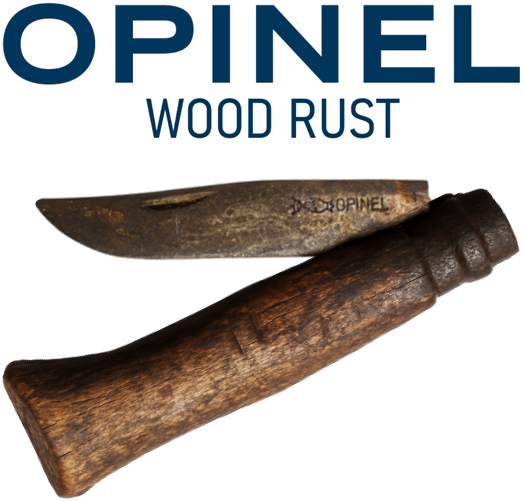
Not pretty. But hey, at least it’s truth in advertising!
Names are an important part of product marketing. Our review knife, only identified as TC21 S110V, as interesting as it is, has no actual name to speak of. FengHua, please fix that, especially if this is still a prototype! And for that matter, the “company” itself has no reliably identified, over-arching name, either. I think I see a trend here! For the remainder of this review, I’m going to call this knife the FengHua knife. I can live with that.
The FengHua knife was just released in June at Blade Show 2025. When this review knife was picked up there for the current set of reviews, it wasn’t even listed on their webpage. That has now changed, but the FengHua knife being sold there isn’t exactly like the one I’m reviewing. It doesn’t have a black-coated blade or pocket clip (I think it’s DLC, but it’s not specified).
WIN+ does have what they call a “blog post”, all 74 words of it (wait until they see this SharperApex post!!), which briefly discusses the tech behind DLC, and it uses their photo of the FengHua knife image for that post (which features an uncoated blade and pocket clip, but the handle might be DLC-coated). It’s the closest indication I can find that the FengHua uses DLC without trying to scratch the review knife with a Torx bit (and I’m not doing that; this isn’t mine to keep).

So given the mystery of the FengHua knife I am reviewing, it seems safe to assume that our knife must be a production sample prototype, but I have no way of knowing for certain.
There are only 7 knives listed on the FengHua Brand webpage, none of which have actual names, but instead just a listing of product composition materials. Of those shown, 4 of the 7 designs offer differing configurations within the knife’s product page, and 1 knife design on the main FengHua page is shown in 2 different models: 1 with an M390 blade and titanium handle and the other with a Damasteel blade and a titanium Damascus handle. The FengHua-branded knives range in price between $359 and $1,679 (GULP!), although the budget-line, WIN+-branded knives, go for as little as $34 (none of which have proper names, either).
The FengHua knife is a marvel of modern knife engineering; it includes 2 new, patented mechanical designs that pertain to the action elements of this knife. I’ll cover these in detail as we get into the review. So let’s get into the review right now!
The FengHua knife, despite having no actual name, is nevertheless a very compelling knife, albeit with a few significant flaws. Whether one outweighs the other is for you to decide.
Blade
The FengHua knife sports a sleek, as sharp as funk, DLC-coated (presumably), drop point CPM S110V blade. It’s a beautiful sight to behold.
Blade Features
The blade design presents a high flat grind, a tiny (at least in terms of height) swedge, a tinier flat, and one of the tiniest blade spine harpoons I’ve ever seen.

The blade also has what some might say is a tiny fuller, although you’d be justified in arguing that point! The “fullerish” groove that envelopes the asymmetric obround, opening hole slot is more of a visual design element than a true fuller, aka blood groove! I mean, c’mon now! Where’s the blood going to go? But as a design element, I like it very much. It’s visually appealing, fits with similar elements milled into the handle, and it shows off the technical bladesmithing prowess of FengHua.
But let’s talk for a moment about that asymmetric obround, opening hole slot. It’s short (too short, really), shallow (too shallow, actually), and buried (too buried, to be honest) in the handle. As a result, it’s less functional than it is ornamental. Yes, it can be made to work, but you have to really want to open the knife this way, and if so, really dig deep to catch it. I am lucky, as my Knife Karen fingers have a little bit of fingernail length to assist with mining that nearly unreachable blade hole slot out of the non-scalloped handle. SMH.

I seem to be on a roll lately with encountering asymmetric obround, opening hole slot knives. And to that end, FengHua needs to take a few ergonomic design tips from Winterblade’s Factor pocketknife on designing an asymmetric obround, opening hole slot that is both aesthetically pleasing as well as easily accessible for opening the blade.

Going back to tiny things (it seems that tiny is an ongoing theme here), check out the FengHua knife’s sharpening choil.

Wow! Is that all there is to it? Sheesh. Is it design-y? OK, sure. But does it serve the purpose of a sharpening choil? Not a chance, Lance.
You’ll be lucky to get at most, 5 sharpenings on this knife with a choil that small – and if you’re at all aggressive with reprofiling, likely even fewer. And worse yet, the primary bevel grind is not very thin, so the blade will need profiling after a sharpening or 2, which will grind away your scarce edge bevel even faster. After all that sharpening work, your FengHua will end up looking something like this:
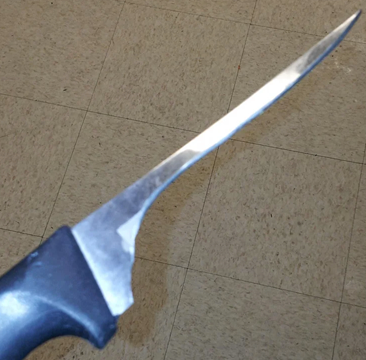
OK, perhaps I exaggerate a bit (ya think?). But the point is dead on. A sharpening choil added to the heel of the blade is supposed to enable the knife to be sharpened many times over the course of its useful life without running into what Spyderco owners know all too well. A small (or non-existent) choil will make your knife look loke crap! Take it away, Spyderco!
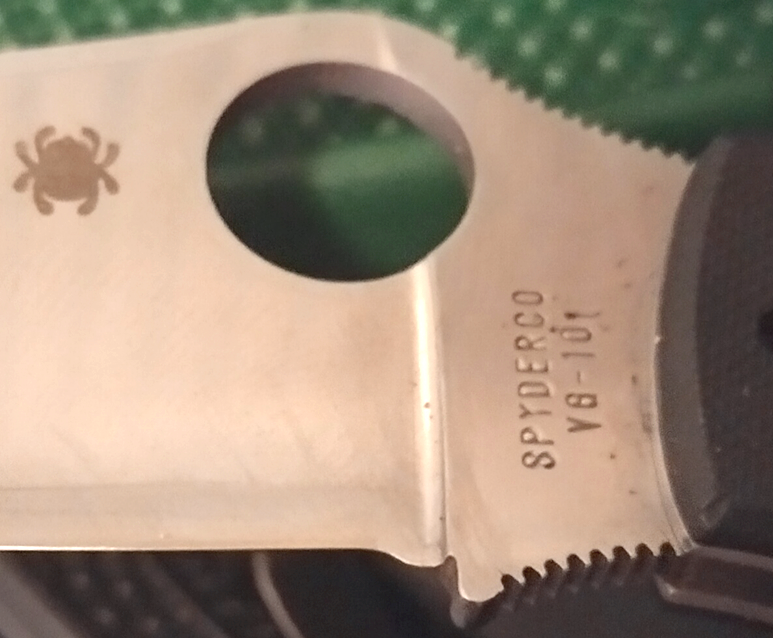
The one saving grace with this knife’s wholly inadequate sharpening choil is that the blade is made from CPM S110V. That steel is the real deal, Neil. You may not need to sharpen the blade for a year or 2 (unless you’re obsessed with cutting mountains of heavy cardboard or fathoms of sisal rope – don’t be that person!). And if you want to store your FengHua knife in your saltwater aquarium, it should do just fine. But whatever you do, don’t try to chop, baton, drive screws or pry with it. This steel is fragile stuff, and it’ll chip or break on you before you realize what you’re doing (it’s not Rex 121, but it’s not all that far off, either!). If the blade breaks, stick a toothpick in it, Betty, because it’s done. Well, unless the break is close to the tip, then you can try grinding it into a Tanto! Otherwise just toss it in the bin, Vin. And even if it just chips, that aforementioned, diminutive sharpening choil will come back to haunt your dreams when you try to reprofile the blade edge to even it out. Ah, good times.
The blade is classified as a high flat grind, plain edge, has clear grind lines between regions (main bevel, flat & swedge) and hosts a beautifully done, curvaceous plunge grind that ends far away from the sharpening choil (too bad the choil wasn’t very well executed). At the other end of the blade is a very precisely ground blade tip, pointy, very sharp (and likely very fragile)!
Opening Mechanisms
We’ve already introduced the disappointing opening hole slot. It’s quite short, shallow, and buried in the non-forgiving handle. You can certainly give it a try, but be prepared to throw a finger joint out in your effort to dig down and attempt to catapult that blade out of its cozy nesting place. Congratulate yourself if you can consistently do it on your first try – it ain’t easy, I’ll tell you that.
The other method is far, far better to use. I’m usually not much of a fan of this style, but given the disappointment of the opening hole slot design, you should instead use the top flipper. It’s really well-designed, and it’s easily my favorite top flipper I’ve used. The tang is enveloped by a large amount of very good jimping (not great, but very good – it’s just barely grippy enough to help the finger hold onto the blade tang, but it works).
The tang’s flipper feature can be used as a front flipper, as it has what I call its “just barely grippy enough” jimping, but where the FengHua knife really shines is at the extended back end of that flipper feature. Given the diagonal cut in the handle sides underneath, this top flipper element has a lot of room to move, and it works with a sweet, push-button action that is amazing. Just a sharp press with your index finger and the blade bursts opens with authority, slamming into its stop pins, locked and ready to go. But if you’re more of a thumb-action gal, whipping that jimped edge back and around with your pollex will snap that blade open before you can say Phil McCracken.
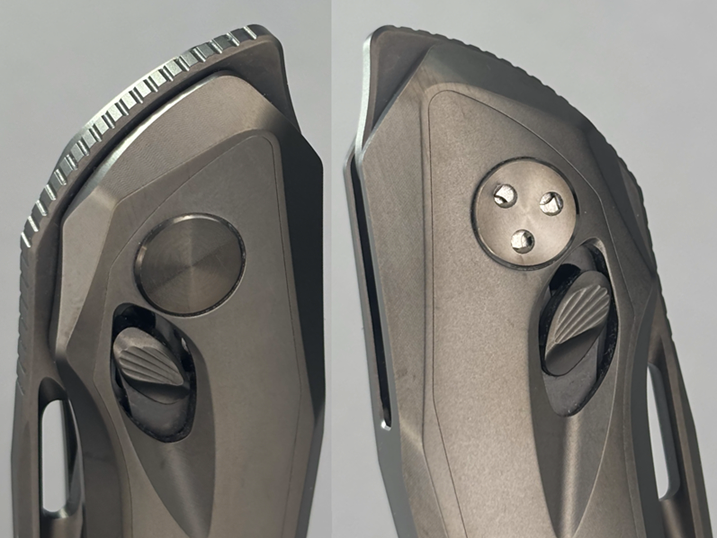
Spine Features
The mention of the jimping above with its “just barely grippy enough” feeling is important. It is real, functional jimping, unlike so many other knives whose designers thought jimping was a visual design feature rather than a functional element in the use of the knife. However, unlike the beautiful, gently grippy jimping along the curvy, crowned spine of my beloved, Italian-made Viper Moon, the FengHua knife uses larger but shallower jimp cuts.

In fact, nearly the entire blade tang is covered with jimping! Aside from the side underneath the top flipper extension, the jimping starts on the blade spine just behind the opening hole slot and ends at the bottom side flat near the choil where the plunge grind begins to taper the blade width. There are 26 cuts along the blade spine to the end of the front flipper & 9 cuts on what would be the choil (and yes, I counted them. Several times. Just to be sure. I did this for you. You’re welcome.) The shallowness of the cuts smooths off coarse jimping ridges, but FengHua retained enough of the cut edges to make it work.
The spine of the FengHua knife is not crowned (too bad, so sad), but the micro-swedge running the length of the blade presents an obtuse angle on each side of the spine. That obtuse angle is good enough to remove any Spyderco-like, finger-ripping, 90° spine-edge sharpness, which is greatly appreciated.
Geometry
As mentioned earlier, the FengHua knife comes “wikid shop” out of the box. And to my great satisfaction, the blade bevels are perfectly ground, symmetrical across both sides and along the full length of the cutting edge. It’s beautiful, precise work that some prominent knife makers do not take very seriously.
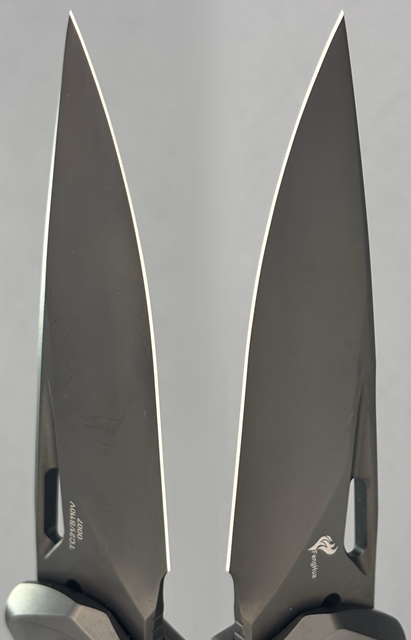
As mentioned above, the blade steel, CPM S110V, is not known (for good reason) for its toughness (at least not in a good way). However, it is very well known for its great edge retention. The blade geometry was properly designed on the FengHua knife to provide maximum benefit to the knife user. Given the blade stock’s non-inconsequential brittleness, the blade’s shallow height (from apex to spine), 24.54 mm / 0.966″, meant the spine thickness needed to be a bit thicker to help mitigate the edge’s tendency for chipping / cracking away. FengHua set the spine thickness to be 3.80 mm / 0.150″ – giving the cutting edge some helpful support. That resulted in a primary bevel of 3° (mathematically, it’s 3.5°, but my goniometer is a bit too crappy to be that accurate). Still, a 3.5° main bevel is pretty thin for a brittle steel, so FengHua ground the blade edge bevel to be a wider 26°, again to help further assuage the blade’s wont to chip and break away under harder use. And luckily, the high flat grind ensures the primary bevel uses nearly all that blade height (the elfin swedge is part of that design).
The only real complaint here would be the design-y, diagonal orientation of the plunge grind. It’s visually appealing, but it compromises a bit of functionality. While this blade doesn’t have thumb studs in the cutting path, the very quick transition from thin, main bevel angle to the full blade width at the ricasso behind the plunge grind is in the cutting path, and it could pose added difficulty for those who want to cut stiff materials like cardboard and use the whole blade edge in doing so. Just sayin’…
But most of all, please remember: this is a knife. I repeat, this is just a knife. A cutting tool. It is meant to slice straight through materials such as paper, boxes, strings, and other materials that are not too hard, but instead soft and spongy, like Twinkies. The FengHua S110V blade is NOT meant for:
- Prying like a prybar
- Lifting like a lever
- Twisting like a screwdriver
- Boring like a drill
- Batoning like a wedge
- Cutting resilient and/or thick materials like wire, carpet & leather (even nylon packing straps & zip ties could damage the edge if twisting is involved)
- Cutting on hard surfaces
- Dropping on a hard surface
- Hammering with or on the blade
- Stabbing anything harder than a plastic bag or a single sheet of paper
Any of these and similar activities can and may very likely result in a range of blade damage, including edge chips, blade cracks, and outright blade breakage. If you think you might need to do any of the above activities, perhaps you should instead look at a nice multitool instead! In case you think I am overreacting, just ask Metal Complex what happened to his beautiful, mirror-polished (and brittle!) ZDP-189 bladed, $1,600 Rockstead HIGO II knife blade. That was criminal negligence, really. As Bruce Lee used to say, “Be like water, not like Metal Complex.”
Blade Markings
The knife has only a modest amount of blade markings, a much appreciated design feature (one that FengHua marketing probably hates, but then again, those people probably don’t carry knives, so they just don’t get it).
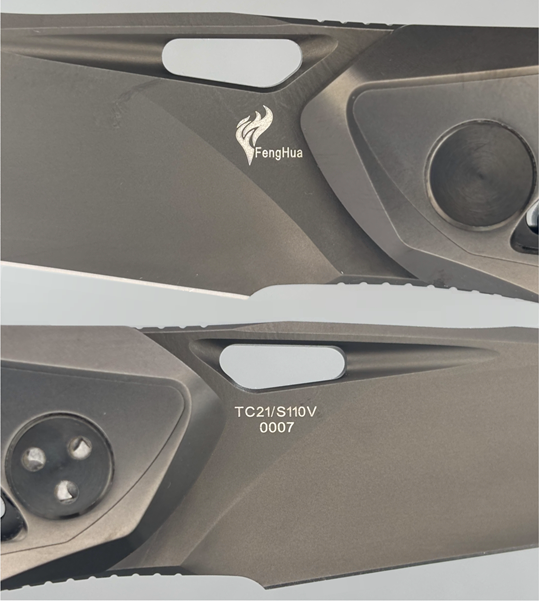
On the show side, FengHua included their company logo and name to the lower right. The logo is quite small, a mere 6.05 mm x 5.42 mm (0.239” x 0.214”). The clip side markings are 2 lines of text: the top line is the, well, it’s either the knife’s primary composition materials, or as mentioned at the start, it’s also its official name, but as we don’t know if that is its official name (although it might be), we’ll just leave that there. The bottom line is the James Bond-ish serial number of the knife (0007). (I told you it must be a prototype!) The markings appear to be printed rather than laser-etched.
CPM S110V TECHE
When I can get the ratings data for the knife steels I review (I primarily gather the data from the authoritative KnifeSteelNerds.com as available), I include it here in a section I call TECHE. What does TECHE mean? Well, you could look at the table below and figure it out, but it stands for Toughness, Edge Retention, Corrosion Resistance, HRc Hardness Rating, & Ease of Sharpening. Clever, huh?
Note that all ratings but HRc Hardness Range are based on a scale from 0-10; Hardness is based on the Hardness Rockwell C scale, which technically is between 20 and 68.

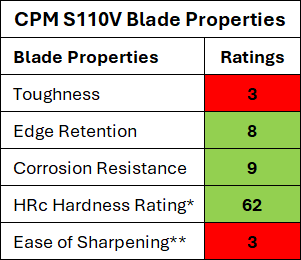
** Ease of Sharpening data is not a rating produced on KSN.
Blade Dimensions
You’ve got the curiosity. I’ve got the numbers.
The length of the FengHua knife’s blade is 82.52 mm / 3.249”, has a cutting edge length of 74.43 mm / 2.931”, and is topped with a swedge that spans 74.50 mm / 2.933” along the spine. The blade height is 24.54 mm / 0.966” and sports a sharpening choil that measures 12.00 mm / 0.473” across and 1.49 mm / 0.059” deep. Lastly, the spine thickness is 3.80 mm / 0.150″, whereas the main bevel edge thickness comes in at 0.45 mm / 0.018”.
HRc Rating
There is none. FengHua didn’t provide that info (as I said at the start, there is a dearth of useful information on the FengHua website, and this is a great example). However, as mentioned above, per Knife Steel Nerds, CPM S110V should be hardened to ~62 HRc. The omission of this manufacturer’s data calls into question the hardness of the steel and how well the blade will preserve that initially super sharp edge. Hopefully this is an information omission rather than an implicit admission of inadequate heat treatments on the FengHua blade steel. But who knows?
Knife Body
Now that we leave the enigmatic (information drought) FengHua knife blade behind, we venture into the area where FengHua finally offered a tiny bit more information. This is also where their patents come into play, so this will be interesting!
Handle
The titanium alloy handle is a black, DLC-coated (I think), skinny little beast that has a host of interesting features that will be discussed in depth. To start with, the sides of the handle are slightly contoured, which is nice. However, those sides are without any texture. This means it’s rather slippery. In fact, they are as smooth as a groove in a move to soothe, with nothing to prove and no rough to remove. All that said, the handle is quite slick, so just a quick flick of your sharp metal stick or a careless hand tick will slice through your kicks like a horrid ice pick, a terrible trick and the resulting blade nick will make you feel sick.
Are you ready to solve the puzzle, or do you need to buy another vowel?
For visual design, the handle has sculpted lateral cuts running along the perimeter, with the edge lines softened for comfort in the hand. This is nice.

The handle also possesses additional, beautifully done milling work that creates sliding grooves instead of sharp cutouts in the handle body. Both the lock release buttons and the pocket clip rest inside these rounded, curved groove slots.
The pièce de resistance for the body groove sculpting is presented along the handle spine. Check this out.
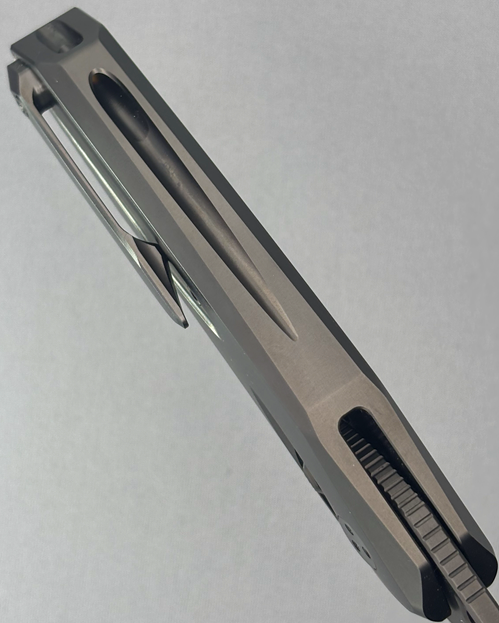
This isn’t your father’s titanium milling work! That groove actually tunnels through the back end of the handle! This is advanced work, and FengHua is just showing off what they can actually do in machining knife handles. Very impressive!
Did I mention that the handle is an integral? How else would they be able to make that handle tunnel! This isn’t your father’s titanium integral handle. No way, Bluejay!
But it’s actually not an integral! The titanium handle is actually a skeletonized frame made for the custom blade lock system that inserts side plates into the handle. Cool? Yeah, it is, and I’ll discuss it below in the Locking Mechanism section.
Did I mention that the handle is made from titanium? Yup, it is. But wait! This isn’t your father’s titanium knife handle! Typical pocketknife titanium handle material is made from Ti 6Al-4V, aka Grade 5 (in the US) and TC4 (in China). Ti 6Al-4V stands for a titanium alloy that is made with 6% Al (and that is “al”, not “ai”, in case it wasn’t clear), the elemental symbol for aluminum (or as the rest of the English-speaking world mispronounces and misspells it, aluminium! Jeepers, get a Webster’s dictionary, folks!), 4% vanadium, and after an additional ~1-2% of trace elements, it’s ~89% titanium. This is the good stuff, right? It has to be good enough for FengHua, right? Ah, not so fast, Buckaroo!
New Titanium Alloy: TC21
The FengHua knife is walking around Pocketknife town with a new set of titanium dress clothes and a bit of an attitude, pushing the geezer Ti alloys out of its way, and it appears to be deservingly so. TC21 is a (relatively) new Ti alloy, developed in China around the mid-2000s (that’s new compared to Ti 6Al-4V, which was developed in the US around 1951, 55 years before TC21). TC21 is a more complex alloy, composed of the following chemical elements:
- Al (aluminum): 6% (technically 6.5%)
- Sn (tin): 2% (technically 2.2%)
- Zr (zirconium): 2% (technically 2.2%)
- Mo (molybdenum): 3%
- Cr (chromium): 1% (technically 1.5%)
- Nb (niobium): 2% (technically 1.9%)
- Si (silicon): 0.09%
- Trace elements: ~.03
- Ti (titanium): ~82.5
Like Ti 6Al-4V, TC21 also goes by a name based on its elemental composition. So perhaps it’s not an accident for FengHua that a knife they call TC21 S110V uses a handle material also commonly known (at least among metallurgy geeks) as Ti-6Al-2Sn-2Zr-3Mo-1Cr-2Nb-0.09Si! Hoo-ah! Geeks rule!
So why use TC21? Well, as an engineered alloy upgrade to Ti 6Al-4V, TC21 brings a number of advantages to the table, including:
- Greater strength
- Greater hardness
- Greater fatigue resistance
- Greater damage tolerance
- Better control of its microstructure
- Higher heat tolerances
- Greater reliability and service life
TC21 is optimized for higher levels of several performance factors, but trades off a bit of higher brittleness and lower machinability compared to Ti 6Al-4V. These feature improvements are why it was developed for and widely used in the Chinese aerospace industry. Here’s a bit more detail on the feature comparisons between TC21 and Ti 6Al-4V (you know, for us metallurgy geeks):
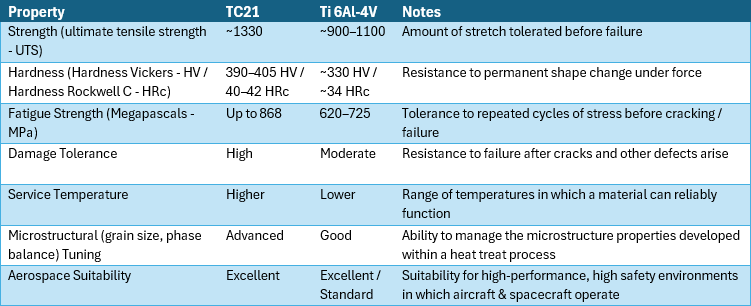
This is all well and good, but are any of those advantages going to make a difference in the way a pocketknife handle works, looks, performs or lasts? Oh, heck no! Then why use it? Great question (I wish I had thought if it!). Truth be told, you simply cannot discount the significance of the uber cool factor! After all, that’s why we all love TI 6Al-4V titanium handles – you don’t need it, but you still want it. So when you want extra cool factor, get the best of the best! And as it is, the FengHua knife is one of the early adopters of TC21 as a knife handle material, making it really very cool. If only I could tell the difference…
Pivot
So FengHua is apparently just a bunch of engineering geniuses. For this knife, they invented a brand new pivot system! Well, actually, they invented a whole new pivot fastener washer. It sounds much cooler the first way, though. They call their new, patented pivot technology “The pivot axel anti-rotation system”. On their website, they describe it thusly:
“The present invention uses a hexagonal gasket washer body to be fixed in conjunction with the outer edge of the hexagon at the top of the hexagonal nut. It’s suitable for assembling objects using screw bodies, the object needs to have an opening that matches the hexagonal gasket body. The outer edge of the hexagonal gasket body is fixed in conjunction with the opening of the object, so that the screw body cannot rotate and the screw will never loosen. The screw has a good anti vibration effect.”
Well, to be fair, it’s not just a washer, but you have to admit that it’s really fun to say! The folks at FengHua included an image of their new technology on their homepage (their subdirectory under myshopify.com). There, that image is so tiny that most of the text is unreadable (although that might just be my old eyes!).
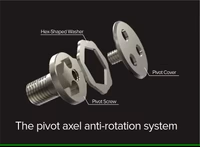
Can you read it? It’s a tiny 200 x 147 pixel image!
Apparently, what they’ve created here is a 3-part, double-screw pivot system that has a hexagonal washer in between. It works by having the actual pivot screw, a 3-node security screw, fastened into place. The top feature of the 3-node screw has an external, hexagonal 3-arm feature (where the arms are separated by the 3 node slots) that is milled to accept the washer. That washer is hexagonal both internally and externally, and the external edges have some sort of loose serrations. The 3-node pivot screw also has a small threaded hole in its center, so once the washer is in place, the top screw, a 3-hole security screw (where the 3 holes are actual holes, not cylindrical sockets) is screwed into place. At this point, the hexagonal washer with its serrated edges, locked into place with the top screw, acts as a lock to prevent the underneath pivot screw from loosening. How Fancy Pants!
This all sounds really great, right? Yay! But now think for a second. This also means that you’ll need a proprietary, 3-node bit driver tool, to remove the pivot, one you most certainly don’t already have. Boo!

While all this engineering work is patently cool (see what I did there?), it seems to be an over-engineered solution to a simple problem. To me, a tiny bit of blue threadlocker accomplishes the same result, requires no proprietary tool to separately buy (and lose), minimizes the number of small parts (to lose), won’t collect gunk in holes (see above), and could possibly reduce the product price by not having to pay for a special, patented feature.
Now that the persnickety proprietary pivot parts have been discussed, let’s talk about more standard pivot features.
I have to assume the pivot is captive, as there is no means to hold the show side, flat-milled, black-coated (DLC?) steel pivot face in place, and I don’t have the special, 3-node bit driver tool to disassemble it. Additionally, due to the lack of that unobtanium pivot tool, I can’t examine the pivot joint parts. I want to assume the pivot runs on bearings, but look at the bearing cage below (it’s much clearer in person, so go get one and look for yourself): it doesn’t at all look like phosphor bronze or brass. It looks like, well, a silver-metal part! What? Is this thing running on stainless steel cage bearings? Bearings in a stainless steel race? Perhaps stainless steel thrust washers? (All of these exist, BTW.) What is this mysterious part? Once again, the FengHua knife is an enigma.
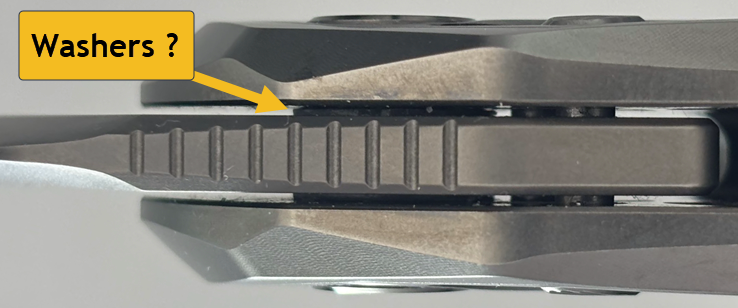
Whatever mysterious metal is used to reduce friction with the blade’s rotation, enable smooth, consistent blade action, and stabilize the blade in the handle, they are doing their job admirably well. The blade centering is dead-on. Good work, mystery material.
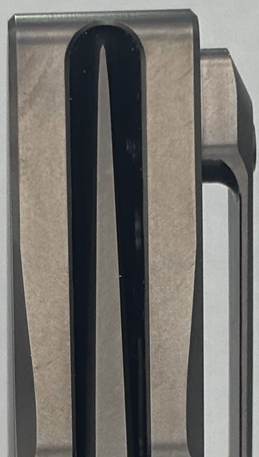
Locking Mechanism
While the pivot was “interesting” in terms of the engineering done by FengHua, it’s nothing compared to the locking system. The whole thing is a patented contraption that is unlike anything I’ve seen before (I guess that’s why it’s patented). There are 2 elements to this unique locking mechanism. Let’s take a look at what we have, but please remember that there is no documentation that came with the knife. The FengHua website briefly describes it in marketing language, and I am only discern what I see without disassembling the knife (once again the lack of that proprietary pivot tool of legend rears its ugly head!).
Push Button Lever Lock Structure
Get ready for this. I don’t know how to tell you except to say everything you knew about unlocking folding pocketknives is now obsolete. The intuitive must now be forgotten. The unintuitive must be accepted as intuitive. It’s weird. It’s unlike anything you’ve (likely) seen before. In fact, it’s bass-ackwards!
Think of it this way. Imagine something you do is so common that it’s just instinctive. Now reverse that with the FengHua knife.

Yeah, it’s like that.
To disengage the FengHua knife’s lock, you have to push the lock release buttons forward! Yes, I said push forward! How does that sit with you? Let me get into the mechanics of it and then we’ll discuss rude opinions!
Here’s how the FengHua website describes this eccentric process:
“The downward pressure button lever lock structure folding knife is connected to the front handle, blade, and back handle by setting an installation mechanism, the blade and spring and lock are against each other. By driving the unlocking plate to move through the installation mechanism, the spring locking plate can be misaligned and matched with the blade, which can quickly lock or unlock the blade. So when using the knife, it is easier and more flexible to open and close the blades, greatly improving the convenience and safety of knife use, and achieving better overall effectiveness of the knife.”
Uh, yeah. I’m not sure that explanation did this particular, peculiar process justice. To do so, we need to get into the other half of the patented locking mechanism, so let’s go.
Lateral Elastic Axis Locking Structure
Remember when I mentioned the TC21 titanium alloy handle in the section above (did you actually read that part? There will be a pop quiz at the end of the class)? I revealed to you that handle was actually a 3-piece unit, starting with a skeletonized frame. But I didn’t tell what went into that frame. Now I will. It’s the entire functioning part of the FengHua Lateral Elastic Axis lock (oh boy, don’t let the Benchmade attorneys hear about this potential trademark violation! Those folks don’t play games!). The lock structures are cartridges attached to a pair of titanium plates that house a set of coil tension springs that s t r e t c h, not compress like most pocketknife locks that use wire-based springs (now you see why you have to push forward on the lock release buttons!).
FengHua also explains this patented knife lock feature on their website:
“The locking structure of the folding knife allows the locking rod at the front end of the two shrapnel to grip the fixing groove of the blade, making it easy to fix firmly. Moreover, the screw structure is designed to unlock and secure the blade by pushing the screw up and down, which is very practical. And it is equipped with a flipper, making it very convenient for the blade to open quickly.”
They add another unhelpful, microscopic, 200 x 128 pixel image so you will grok this process.
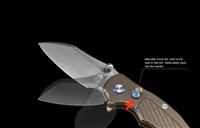
Now do you understand? Neither do I. But I was determined to get to the bottom of this additional enigmatic feature of the enigmatic FengHua knife – all without being able to disassemble the bloody pivot and remove the lock plates from the handle frame (what a champ, eh?). Note that I could be totally wrong on this (that would be the 4th time in 45 years), so take this analysis with a salt mine of, well, salt.
First off, note the beautiful milling work done to mate the lock cartridge plates into the titanium handle frame. You can see the seams, but they are done extraordinarily well. Kudos the folks at FengHua who are in charge of the CNC machines.
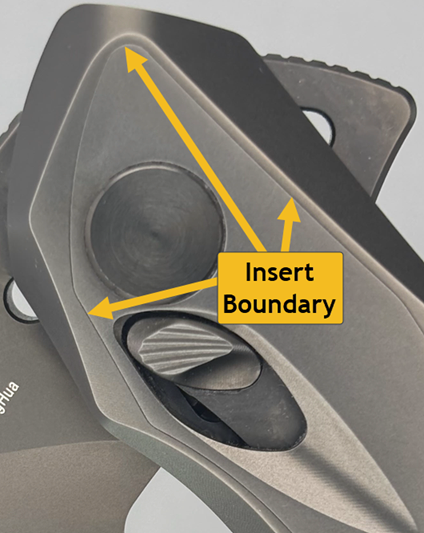
There are 2 such cartridge plates, one for each side (and 1 coil tension spring in each). Pushing the lock release button away from your hand pulls the coil spring, embedded in a slot milled into the cartridge plate, driving a mechanism (that I cannot directly see but can infer the action by the resulting functionality) that affects a pair of lock pins.

When the knife is open, those lock pins neatly slip backward into what appears to be a slot milled into the blade tang underneath the top flipper feature. Pushing the buttons forward drives the lock cartridge mechanism forward, pushing the lock pins away from the rear of the slot, thus freeing the blade.
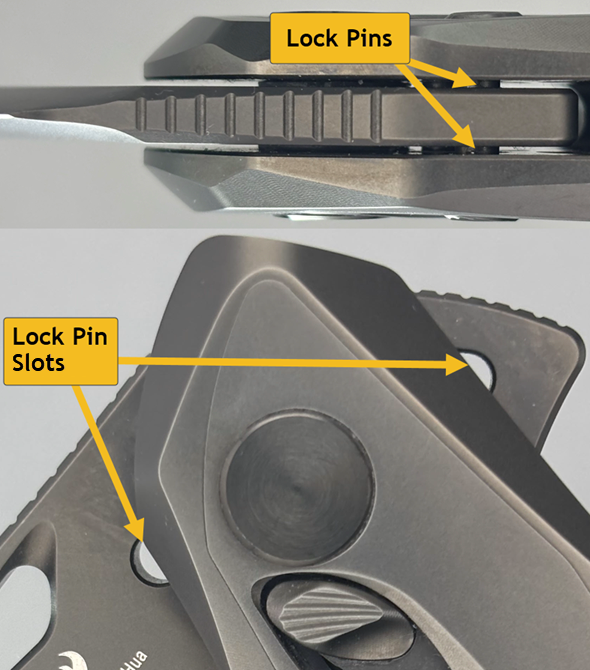
Those same lock pins appear to also serve as the blade’s detent with another milled slot, designed so the detent can be easily broken when opening, placed just behind the ricasso.
The position of the push lock release buttons changes with the positioning of the locking mechanism.
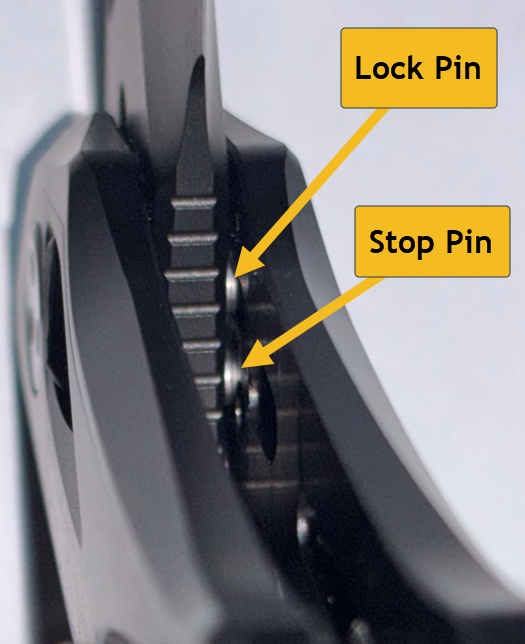
When the blade is fully open and the lock pins are sunk into the open lock pin slot, the lock mechanism sets the lock release buttons in the far rearward position. When the blade is half open, and the lock pins are against the flat, non-milled portion of the tang, the lock release buttons rest in the far forward position. Given all that, when the blade is closed, the lock release buttons are position in the center of the sliding lock mechanism, which seems to support the notion that the blade closed position uses the lock pins in the 2nd slot as the detent (and I can’t find any other mechanism that would be the detent, but I restate the caveat that the non-removable pivot masks a fair bit of the action mechanism in that region).
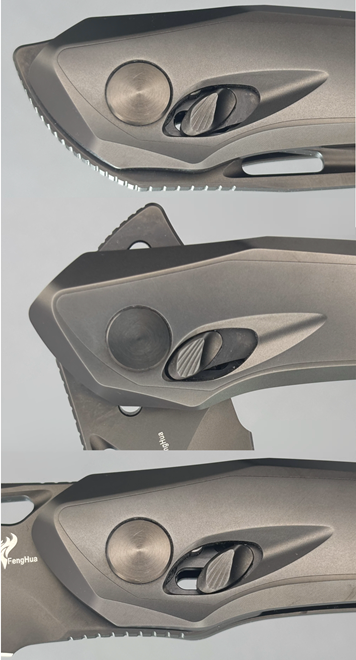
Overall, the push button lever lock mechanism with the Lateral Elastic Axis Locking Structure makes up a fascinating and genuinely complex knife locking system, created by clever engineers and talented machinists. But is this system any better than what’s already out there? I’m going to argue it is not. I think the Achilles Heel of the FengHua knife’s locking system is that you must push the lock release buttons away from you. There’s a reason that the Benchmade Axis Lock (the original one, not the trademark infringing FengHua one), the Snecx Superlock, the Demko Shark Lock, the Microtech RAM Lock, and the Spyderco Compression Lock, all use retraction action to release their locks.
Human Hand Anatomy
Per the structure of the human hand, it’s easier and stronger to pull (flex) than to push (extend) when operating spring-loaded mechanisms. The human hand and forearm are anatomically and biomechanically optimized for pulling actions.
Human hands evolved for grasping, holding, pulling, and manipulating objects toward or within the palm. Flexion (closing the hand, pulling) is the dominant motion for strength (e.g., gripping a branch, pulling a rope, squeezing a trigger). Extension (opening the hand, pushing) is necessary but less forceful; it’s more about releasing or opening the hand, not executing a powerful action.
Structurally speaking, flexor tendons run along the palm and are protected by strong fibrous sheaths. Extensor tendons on the back of the hand are more exposed and delicate. The bones and pulleys in the hand’s biomechanical structure amplify flexor strength but do not for extensor force.
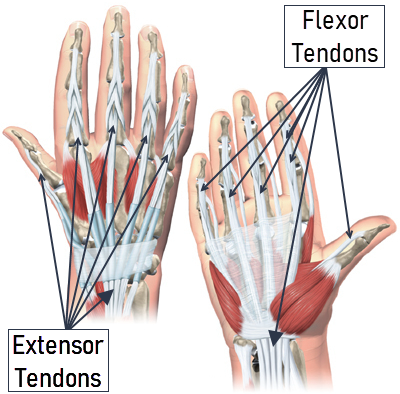
The practical implications of these hand structures for manipulating spring-loaded devices are clear. Pulling a lock release button, a trigger, or a lever feels easier, is done with more precision, and has the capacity for greater force. The hand’s joints, muscles and tendons supporting flex action are much stronger, fatigue far more slowly and have much finer motor control. On the other hand (see what I did there?), for pushing a spring-loaded button or lever away, the hand structures are much weaker, fatigue faster, require more awkward muscle engagement, and offer significantly less precise motor control.
There are additional and important aspects of pushing vs pulling this spring-loaded knife lock release button mechanism. When pulling a knife lock release button, such as a crossbar, the user is typically pulling the knife handle into the palm of their hand, which secures the handle against backward motion, enabling an easier, more consistent action. Pushing those buttons away inherently drives the knife handle out of their hand, requiring greater (and fatiguing) finger strength to hold the handle from slipping (and the non-textured handle on the FengHua knife is rather slippery already).
Lastly, there are more than just logical and physical reasons why the push away locking system is just wrong. Pushing the tension-spring-bound lock release buttons forward with your thumb also pushes the thumb toward the FengHua knife’s hyper-sharp blade edge. One slip and you’re seeing your finger skeleton. As George Thorogood would have said, this knife would be “B-B-B-B-Bad to your bone”.
Let’s sum this up. Does the FengHua forward push button blade lock release system work? Yes. Can you adapt to using it? Yes, eventually. Does the innovative mechanism solve an existing problem? No. In fact, it introduces new problems. The issues identified above are all solid reasons why the push action of the spring-loaded lock release buttons of the FengHua knife lock is a solution in search of a problem (when there’s none to be found). It’s a dubiously awkward solution at best, and potentially a quite dangerous one for the user’s health (and blood supply).
I’m not a fan of this needlessly complex design (could you tell?), no matter how groundbreaking the engineering behind it is.
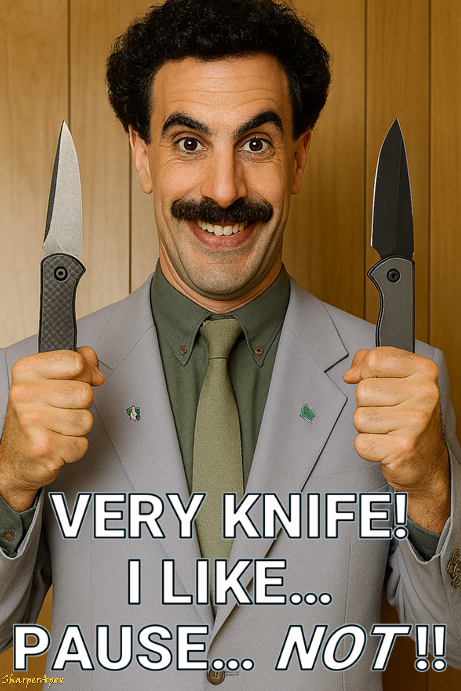
Sticks, Rocks, Play and Lashes
As stated above, the FengHua blade lock does functionally work to secure the blade in place. There is absolutely no lock stick, lock rock, blade play up-or-down or side-to-side, pivot lash, or detent lash. The precision machining of this blade pivot is remarkable.
The detent is quite soft, however. Without a detent ball, there simply isn’t any snappy detent break. Most button plunge lock systems have more detent than the FengHua knife. I also noticed what seemed to be a bit of double-clutch in the lock release. You push the lock release buttons up, and the blade releases and then immediately stops. Experience with the FengHua knife helped me realize that properly using the lock release button system is paramount. You need to push the lock release button all the way up and then immediately release it. Otherwise, if you hold the release buttons up, the lock system gums up and you’re then dealing with residual detent hang-up. I learned how to make it work, but once again, like the lock release button action itself, none of this is intuitive. A knife at the cost of the FengHua knife, it should be. It must be.
Stop Pins
There are 2 stop pins, mounted on each side of the handle, and run along a slot milled into the blade tang. They are perfectly placed to prevent so many of the assorted sticks, rocks, play and lashes mentioned above. And since I can’t disassemble the pivot, that’s all I can say about that. Done!
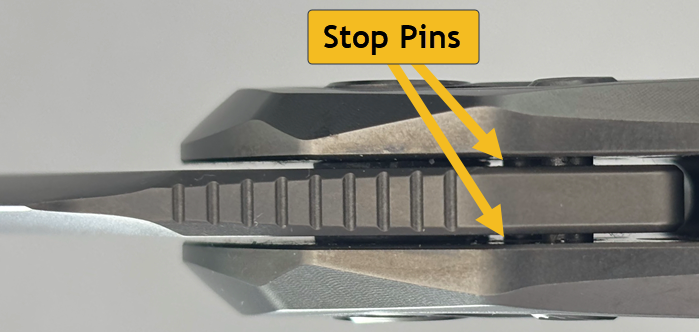
Lanyard Mount
Oh, this is really big news for Jordan, Kent, and Owen, the last 3 dudes on the planet who care about lanyards. They are already stocking up on Type III 550 paracord as we speak.
Remember when we covered the body groove sculpting along the handle frame spine at the beginning of the Handle review section? I didn’t mention this detail there as I wanted the lanyard boys to be surprised. Just look at what FengHua did for them! Because the frame of the handle is a beefy chunk of TC21 titanium alloy, and they only needed to skeletonize the sides to install the lock mechanism, the rear of the handle is still solid titanium. So to show off their milling prowess, FengHua created a beautifully rounded, deeply milled groove along the back, and went deep enough to create a tunnel out of it, just to make Jordan, Kent, and Owen ecstatic (it must be nice!).
For the rest of us, the non-lanyard public at large, we get a lovely, milled feature that we can enjoy! I do, but I won’t corrupt the visual aesthetic of the FengHua knife with a braided piece of string. How about you?
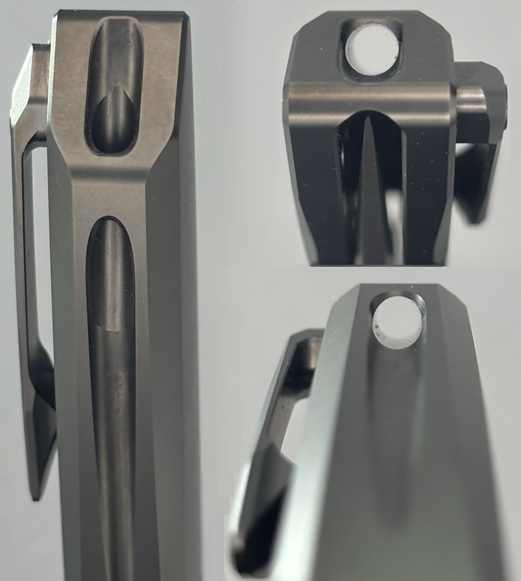
Handle Dimensions
Are you curious about the handle dimensions? Well, I will list them here anyway, because it’s my post and I like numbers! Besides, I paid for these calipers, and I want to get my money’s worth out of them!
The length of the handle is 108.66 mm / 4.278″, and given the blade length is 82.52 mm / 3.249″, the knife has a blade-to-handle ratio of 0.76. The height of the closed knife handle is 26.05 mm / 1.026″ with a handle thickness of 13.53 mm / 0.533″. The side of the handle, normally listed as the scale thickness, but in this case the handle side thickness, is 4.21 mm / 0.166″. Lastly, the balance point fulcrum of the open knife, where 0.0 is balanced at the pivot, is 16.06 mm / 0.634″ down the handle.
Hardware
The FengHua knife has a DLC (probably?)-coated, medium carry, milled titanium pocket clip that measures 50.50 mm / 1.989″ in length, giving the knife a clip-length-to-handle measurement of 46.5%. The clip is straight, tip up, but is only for right-hand carry (FengHua is so sorry, Mollydookers). It offers a harpoon point aimed away from the handle spine. It’s otherwise rather plain, but that plainness matches the non-textured handle aesthetic. But there is one terrible problem here: the tip of the pocket clip is ridiculously pointy! I mean, it’s awful. Did anyone in FengHua even test this? Did they hold the finished knife in their hands and feel that syringe-like tip? OK, it’s not really that bad, but it does feel like a mini tribute to the knife’s blade, which has its own sharp, pointy tip. The photo below doesn’t really do justice to that pokey, skin-abrading tip, but feeling is believing.
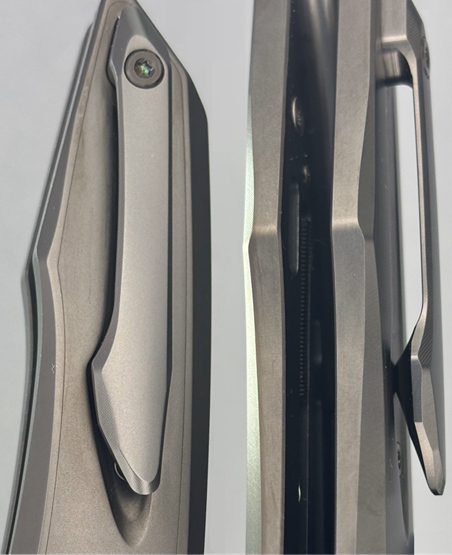
There is exactly zero hardware on the show side of the knife, with the exception of a DLC (maybe?)-coated, flat-milled, plain-designed steel pivot. There’s no pivot collar, but there’s no room for one, either. On the clip side you have the aforementioned proprietary, 3-node steel pivot screw. You also have a single pocket clip screw, and that’s all – unless you turn the knife sideways and look under the pocket clip, where you’ll find a second handle screw underneath the clip’s toe ramp.
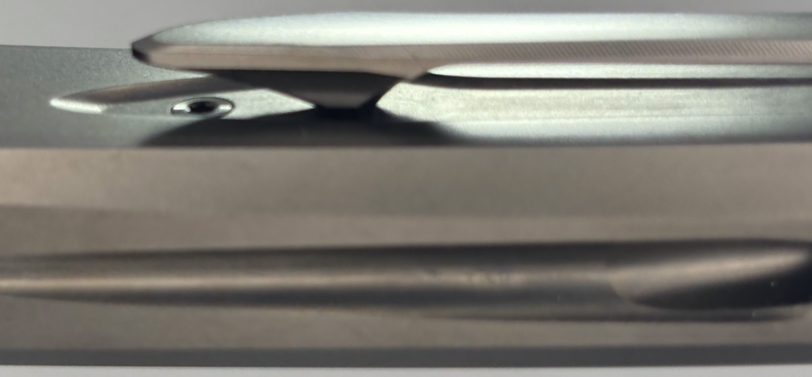
Ergonomics
The ergonomics of the FengHua knife are not bad, but they could be better. It’s a mixed bag of results.
The blade sports an abundant amount of jimping along the blade tang, although the jimping in the area adjacent to the micro-sharpening choil seems to be for aesthetic purposes, as no one asked for more grip there (unless it’s to help you grip the underneath side of the blade so you’re less likely, when releasing the push-forward blade lock, to cut your thumb down to the bone. You don’t want to see your own bones. That’s never a good thing).
The jimping is moderately grippy and it works; I’ve felt better, but I have definitely felt worse! There is no crowning on the blade spine. The swedge makes what would be a sharp 90° edge (cough, cough Spyderco!) into an obtuse angle, but those edges were not really smoothed over. It’s not bad, honestly, but a luxury knife, and the FengHua knife is definitely in that category, should have been done better than this.
The blade’s top flipper is excellently designed and works as well as anyone could expect. On the other hand, the opening hole slot is too small and buried too deep into the handle (aka the handle is not milled down enough to provide adequate access to the opening slot). If you practice with it, you can eventually figure out the nuances and get it to open, but it’s still hard to do, so you (or at least, I) don’t get that powerful slam, and thus I don’t find it as satisfying to use.
The handle has decent hand grip feel because all the sharp edges have been removed with angled cuts, and any remaining edges have been removed without leaving the handle looking like a rounded marshmallow. The handle is slightly contoured and nicely smooth to the touch, but as you know, smooth isn’t how sharp knife handles are supposed to feel. You want a texture that is comfortable yet grippy, so the knife won’t slide either forward or backward (especially backward, as that means the blade’s coming for your fingers, and guess what? You’ll be getting a sneak peek at your finger bone).
The ramp toe of the milled pocket clip sits in a smoothed, recessed spot on the handle, so it won’t shred your pants pocket, although the clip is still fairly high off the handle surface. And because the tip of the pocket clip is needlessly sharp, this is a seriously problematic hot spot.
Weight
TC21 must be a dense material. The FengHua knife is all of 181.73 mm / 7.155″ long with an 82.52 mm / 3.249″ blade, and the handle is only 13.53 mm / 0.533″ thick and 19.33 mm / 0.761” tall (open blade), but the knife weighs 99.45 g / 3.508 oz., giving it a weight-to-blade-length ratio of 1.21. That’s fairly robust for such a narrow handle knife. However, that also means it has a great, solid hand-feel, lending confidence in it as a knife. I like that, as I am not a fan of super light-weight knives (cough, cough Opinel).
Design Considerations
The FengHua knife is as much a design-strong knife as it is an engineering-forward knife. FengHua is happy to show its titanium milling skills (and since TC21 is harder than Ti 6Al-4V titanium, it’s harder to machine, making their work all the more impressive). They do so with panache. They are more than happy to mill very smooth, angled hole slots into the handle as well as the blade itself (around the opening hole slot).
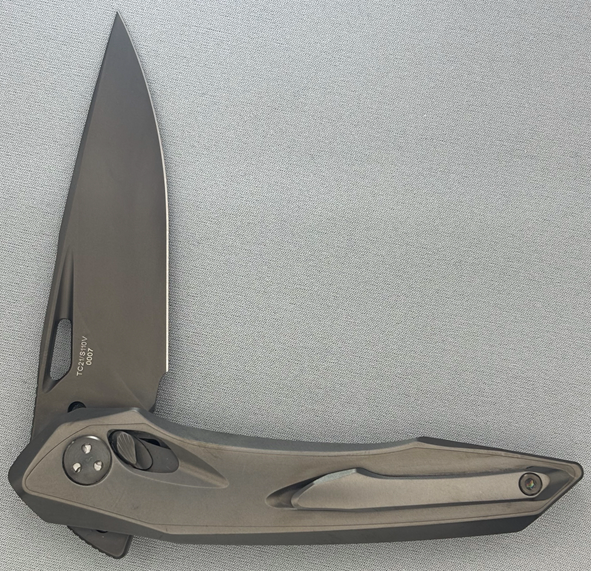
The blade, with its tiny swedge, tiny spine harpoon, clean plunge grind lines, and perfectly ground edge bevels, are really attractive features.
But for me, the most impressive part of the FengHua knife design is the blade lock system. More specifically, the engineering and machining work done on the handle to implement that locking system is genuinely impressive (definitely not the lock functionality part, unfortunately). Look at the tolerances of those inserts along the main knife frame. These aren’t decorative features. These are the critical junctions where the blade lock mechanism plates fit into the frame, and it’s flawless work.
But knives are more than just engineering and design features. Those features have to benefit the use of the knife for the user. In several ways as discussed earlier, the FengHua knife is a beautifully engineered & designed knife with significant engineering & design flaws. Of course, I am sure this is a prototype version, and I truly hope FengHua can resolve these issues before the knife goes into full production.
Original Packaging
As the knife I am reviewing was lent to me for a review, after which I have to send it back, the only packaging I got was a cheap, generic zipper pouch, which I imagine (and truly hope) is not the final packaging. Not that I like to see so much of my pocketknife purchase spent on frivolous side expenses like overly fancy packaging, but uber cheap packaging does convey a rather negative first impression. I hope FengHua figures out the right balance.
Knife Karen Nitpicks
The FengHua TC21 S110V knife is a beautiful knife made with excellent materials! I mean, it would be fantastic if they only fixed a few things. I’d really be more impressed if not for a few of those big misses. Really, whose idea was it with those things? C’mon, man! Be serious! These mistakes are game changers! I need to talk to a manager!
- The knife has no name! It’s basically called “<manufacturer> <blade material> <handle material>” (fill in the variables). Who thought that was a good idea?
- The company’s name is not clear. FengHua is a brand, but the company name might be WIN+ or it might be Dreamtech, depending upon which page on their website you are visiting. Who thought that was a good idea?
- The company has no real website. They are sitting in a subdirectory off the root domain, MyShopify.com, instead of building up a brand name presence on the web with a custom domain name, hosting their own website with pages about their products, their founders’ story, their product warranty, the reasons why their products have better value, and more. Google loves that crap. They need to stop skimping on brand-building activities with their web presence built off the MyShopify domain. Who thought that was a good idea?
- Their knife pages only have 1 photo per knife. One photo! Yes, it’s 2 images in one photo, with an open and closed view, but this is totally inadequate marketing for a $650+, ultra-premium pocketknife! Who thought that was a good idea?
- The lock release button action is backward! You push it instead of pulling it. You have to push your thumb up against significant tension spring pressure toward the super-sharp blade edge to unlock the knife. Who thought that was a good idea?
- The knife’s detent is weird. The detent when closed is surprisingly soft. But when you unlock the open blade, it falls for micro-second and then stops, caught on that detent system! Classic double-clutch! If you don’t figure out you need to immediately release the lock button, the blade just won’t fall closed. Who thought that was a good idea?
- The opening hole is a narrow slot that’s placed too deep into the handle, which has no opening hole access scallop, making it far too difficult to reliably use the hole to open the knife. Who thought that was a good idea?
- The sharpening choil is all of 1.18 mm / 0.047” (that’s 3/64 for you fraction fans) deep. It’s tiny! How many sharpenings can you get out of that before your very expensive knife FengHua looks like a smiling Spyderco? Two? Who thought that was a good idea?
- The fancy pants, patented knife pivot system cannot be adjusted at all without using a proprietary tool that you will lose a week after your purchase. Who thought that was a good idea?
- The price of this knife, coming from an unknown Chinese knifemaker is an absurdly high $652, making Benchmade prices almost seem reasonable. Who thought that was a good idea?
- A $650+ ultra-premium pocketknife containing 2 patented, engineering features also comes with a lanyard hole so you can tie a string onto it. Who thought that was a good idea?
Price
Brace yourselves. This fancy folding knife, made by a largely unknown cutlery manufacturer located in Yangjiang, Guangdong, China, sporting a CPM S110V blade and a new titanium alloy TC21 handle, has a price tag of $652. Yep, that’s the truth. $652. That’s a lot of Girl Scout cookies, ya know? (Technically, it’s more than 2,980 Thin Mints, in case you’re counting.)
Looking online, almost everything made by Reate sells for less than that, and Reate is a well-established brand with a top-tier reputation for build quality. There is a gorgeous knife made by Bestech that has both Damasteel and Timascus inlays in normal pedestrian titanium, but with beautifully milled handle scales; it sells for $778, but Bestech is a well-known and respected knife manufacturer. Even the relative newcomer (at least to me), Poikilo Knives, whose fast gaining a reputation for building extraordinarily impressive knives with absurdly high-quality pivot action (at least per Metal Complex; I haven’t been graced with the opportunity to try one yet), only has 5 out of 27 knives more expensive than the FengHua knife. MC readily admits that Poikilo knives are overpriced but the quality is second-to-none (at least in China).
Not that my opinion matters one whit to the folks at FengHua, but I think they may want to rethink their approach. To enter an already crowded, high-end, folding knife market as an unknown entity and attempt to sell a new product at such a high price, especially when one of its claims to fame is an oddly unintuitive, over-engineered knife lock system, well, I see this as a miss. Clearly, they have the talent and skills to make stand-out knives, but I think they would truly benefit from attaining a first big win knife release at a price more accessible to more knife buyers before they try for a wild, round-house swing. After all, WE Knives didn’t get to be so overpriced without first earning a reputation for making excellent products.
But what do I know about B2C selling and marketing products like knives? I’m just an old woman who enjoys writing knife reviews as a hobby!
Verdict
The FengHua TC21 S110V knife is a bit of an enigma. The knife doesn’t really have a name as much as a designation of materials used in the knife. The company is largely unknown, and for that matter, the company doesn’t seem to have decided upon its own name (it could be WIN+ or Dreamtech); at least we can agree that FengHua is the premium brand name of whatever the company is called. The knife I have reviewed seems to be a prototype. It doesn’t say “prototype”, but its design accoutrements do not exist on the FengHua website (this knife’s blade and pocket clip seem to be DLC-coated, but the listing there shows a non-coated blade and pocket clip).
The knife itself, picked up at Blade Show 2025 by the person who lent it to me for this review, came with nothing. No documentation, no original packaging (I really hope the uber-cheap, nylon folding zipper pouch I got with it is not the final packaging!), not anything at all! The webpage for the knife is as minimalist as can be. There are only 2 images (in the same, single photo): one of the show side blade open above another with the clip side handle closed. Any additional knife information there, even just the specs, is so minimal as to be nearly useless for writing a review. Luckily, I persevered!
The FengHua knife (as I called it in this review), as FengHua TC21 S110V just doesn’t roll off the tongue as well) is a beautiful knife. Despite its blade length of 82.52 mm / 3.249″, the knife’s narrow-bodied, upgraded titanium alloy handle really seems in hand to be quite a bit larger than what its diminutive open length measurement of 181.73 mm / 7.155″ might imply.
The materials used in the FengHua knife are more than impressive. The black-coated blade (I think it could be DLC, but there’s no information at all) is made of CPM S110V, an ultra-premium steel that has excellent edge retention and even better corrosion resistance. Because of the 3-legged stool of desirable steel properties (toughness, edge retention and corrosion resistance), where you only get to pick 2, it turns out that S110V is pretty inferior in terms of toughness. That means the blade’s more likely to chip, crack and break under abusive use. Use it like a knife with its great, long-lasting edge and it should be fine.
The blade can be opened in 2 ways. I am generally not a fan of top and front flippers because you have to adjust the position of the knife in your hand once you open it. However, the top flipper in the FengHua knife is easily the nicest top flipper I have encountered. It’s the best implementation of a system I hate to use I’ve seen so far. Additionally, you get an opening hole. More of an obround, asymmetrical opening hole slot. Sure, fine. That could work. Except it really doesn’t. The hole is too short, too narrow, and most of all, too deeply buried in the knife handle to make it easy to use. The handle sides provide no scallops or cutouts at all to help with access to that opening slot.
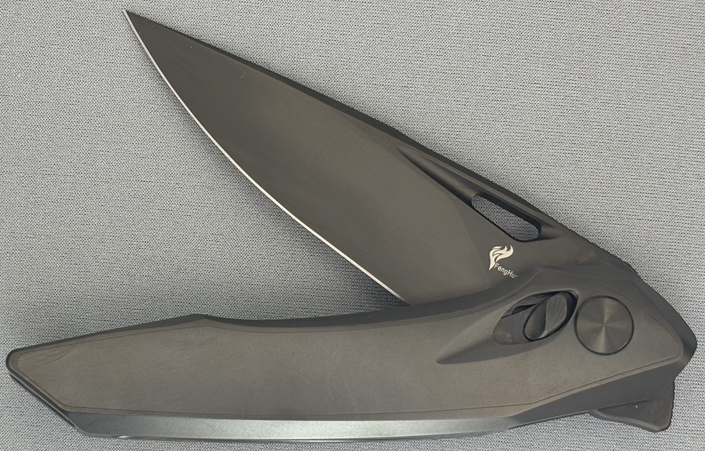
The handle is a big story with the FengHua knife. It’s a titanium integral (right?), but it’s not your father’s titanium integral (did you dad even have a titanium integral?). Let’s start with the titanium. It’s not the standard Ti 6Al-4v alloy that everyone else uses. FengHua uses TC21, a (relatively) recently-developed Chinese aerospace titanium alloy that is, compared to Ti 6Al-4v, stronger, harder, more resistant to fatigue, damage and high heat, has better reliability and longer service life. It is a bit more brittle and harder to machine, but that’s it.
Next, we move into the mechanisms used in the knife. FengHua boasts using 2 separate, patented systems in this knife. Are they great? Umm, I suggest that you be the judge.
- Patent No. 1. The knife incorporates a redesigned pivot screw that uses a 3-piece system made of a proprietary, 3-node security screw, a hexagonal washer, and a second, 3-hole security screw that threads into a center hole of the first 3-node security screw. This system requires a proprietary, 3-node bit driver tool to access / adjust the pivot.
- Patent No. 2. The blade is locked open with a new lock system that uses a pair of coil tension springs that are each embedded in a cartridge plate made from more of the (we have to assume) TC21. The sides of the body are the 2 knife lock cartridge plates that attach to the frame. The release activation of the lock system is done with a pair of what appear to be crossbar studs. However, to make the tension-spring system unlatch the blade lock, you push the buttons forward – toward the blade edge!
Do these multiple patents make the FengHua knife better? Here’s my take. The pivot retaining lock serves as an over-engineered alternative to Blue threadlocker, which would have worked just as well and cost less. It’s interesting from an engineering perspective but is a totally unnecessary and needlessly complicated system. I’d be far less critical about it if it didn’t require a proprietary bit driver to do simple work on the pivot. Seriously?
The locking system is meticulously engineered and beautifully implemented in the handle frame. The gap tolerances between the frame and the lock cartridge plates are fantastically done! I am seriously impressed! The external sides of these plates are slightly contoured and totally smooth, although that means the handle is too slick for a secure grip. On the downside, the locking system itself is even more ridiculously complex than the 3-part pivot. It appears that the clip side lock cartridge plate can be disassembled by removing the 2 pocket clip screws. Assuming so, then the screws on the inside of the show side lock plate would become accessible. I presume the plates disassemble from the pocket clip screws. I don’t know if the pivot must come out to remove the plate, but as I don’t have the required 3-node tool, the point is moot.
I really want to know who thought it was a good idea to require the user to push their thumb hard forward against a tight, spring-resistant lock release button that’s pointed toward the open, hair-whittlingly sharp, blade edge. That’s beyond ridiculous! But truth be told, the fundamental problem here is that you have to push the release buttons forward in the first place. What is this madness? This lock release action is as unintuitive as requiring that you climb into the trunk of your car and sit backwards in order to steer it! This is an engineered solution in search of a problem, and they didn’t find any problem to solve. But they put this system into place anyway.
I will admit the aesthetics of the FengHua knife are beautiful. The ergonomics, outside of the poorly implemented opening hole slot, are very nice. All the elegant, faceted milling work along the handle frame edges, the gorgeous, shallow angle bores into the titanium body along the handle spine and at the lock buttons, and the stunning fitment of the blade lock cartridge plates into it are extremely impressive and pleasing to the eye. The svelte blade shape, the evenness and symmetry of the edge bevels, and the curvaceous plunge grind continue the style into the sharp end of the knife.
But there are just too many odd design choices made with this knife, such as the backward lock action, the failure to offer even mediocre access to the opening hole, the addition of a proprietary pivot fastener that requires the use of a proprietary driver bit tool, and everything else mentioned in this review leaves me with significant doubts about this knife. But once I learned how much this China-based, unknown knife manufacturer wanted for this knife, it all became clear.
The core, enigmatic mystery surrounding this gorgeous knife has finally been revealed. It is a very interesting knife, but it’s not US $652 interesting. Enjoy! ![]()

